Chinese food isn’t exactly known to be healthy – or paleo – but it’s one of my favorite cuisines to make healthier. Shrimp chow mein from the local Chinese buffet is loaded with MSG, carbs, and of course, gluten. But don’t worry – healthy Chinese food is an easy switch to make! This healthy shrimp chow mein recipe is the perfect example. You’ll love the crunchy cabbage, sweet shrimp, and spaghetti squash in place of noodles!
What Is Shrimp Chow Mein?
Shrimp chow mein is a Chinese dish that means “stir fried noodles”. There are multiple variations, but common additions are some kind of protein (chicken or shrimp), vegetables, and sauce made with soy.
Is Shrimp Chow Mein Paleo?
A standard Shrimp Chow Mein is most definitely not paleo. Stacked full of gluten, MSG and soy, it’s kind of a paleo nightmare.
But, this healthy shrimp chow mein recipe is paleo perfection – super quick to make and containing only good things.
This healthy shrimp chow mein also happens to be low carb and keto friendly, if you skip the coconut sugar. It’s bursting with nutrients from all the vegetables!
Is Shrimp Chow Mein Healthy?
Regular chow mein is not healthy, but everything about this paleo shrimp chow mein recipe is good for you! Packed full of veggies, with spaghetti squash noodles and using barely any oil to make it, you really could eat this as if you were at a Chinese buffet and keep refilling your plate.
Shrimp Chow Mein Calories
Calories and nutrition info for regular shrimp chow mein will vary depending on what is in it. I’ve seen anywhere from 150 to 500 calories in a serving, but what they all have in common is that they are high in carbs and usually processed ingredients.
This healthy shrimp chow mein recipe is much better at:
- 221 calories
- 6 grams fat
- 20 grams protein
- 18 grams carbohydrates (from vegetables!)
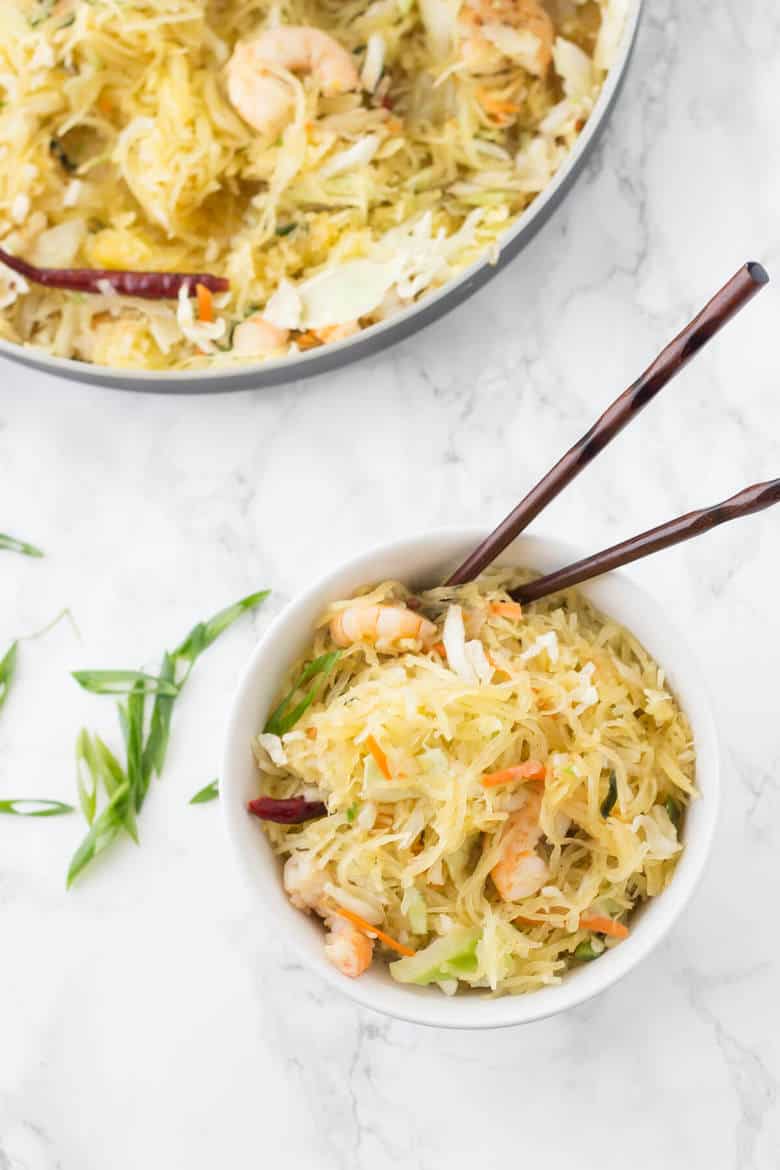
What Is The Difference Between Shrimp Chow Mein and Shrimp Lo Mein?
Some sources say that shrimp chow mein is made with crispy noodles, while lo mein is made with soft noodles, yet in other parts of the country, chow mein can be made with soft noodles as well. I have to admit I’m no expert in the naming convention, but who cares? I’m calling this a healthy shrimp chow mein recipe.
Since this dish is made with spaghetti squash, it’s obviously not identical to the kind made with noodles. But it has all the same delicious flavors!
How To Make Shrimp Chow Mein (The Healthy Way!)
To make paleo shrimp chow mein, you’ll make your spaghetti squash noodles, then stir fry the veggies, shrimp, and slaw mixture.
- Bake the spaghetti squash. In an oven preheated to 375 degrees F, bake your squash for 40-50 minutes, until tender. Using a fork, shred the cooled squash into ribbons to resemble noodles.
- Stir fry the veggies – minced garlic, ginger, green onion, chile peppers, and peppercorns – in sesame oil over a medium heat until fragrant (this takes about 30 seconds).
TIP: Be sure to use a pan with high sides. A wok will work the best, but any other pan with high sides will do just fine, too.
- Add in the shrimp and cook just until pink on both sides, stirring frequently so the garlic mix doesn’t burn.
- Add in the slaw mixture and cook for a couple of minutes until they soften slightly.
- Add the spaghetti squash noodles and coconut aminos, and toss to combine. Taste for salt and add a pinch or two if needed.
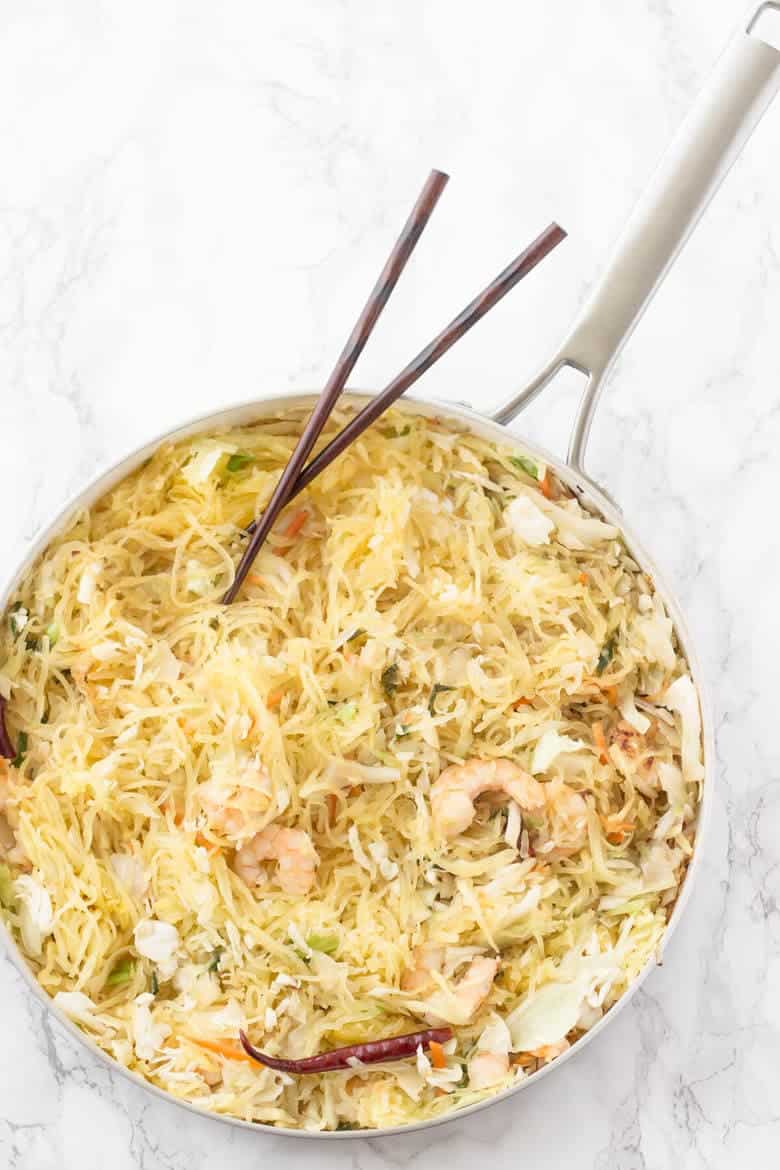
TIP: You can add a pinch of coconut sugar for a little sweetness, but it’s not necessary. Skip it to keep this dish low carb.
You can always throw in some additional veggies if you want to boost the benefits of this healthy shrimp chow mein even further. Peppers, onions, mushrooms… all of it would be good.
How To Make Shrimp Chow Mein In Advance
Yes, you can make shrimp chow mein in advance! The noodles can be made ahead and stored in the refrigerator until you’re ready to use them. Then you just bust out your wok, throw in those other healthy shrimp chow nein ingredients and go from fridge to tasty meal in minutes.
TIP: Once the noodles have been chilled, they aren’t as watery and take on a more crispy texture, like traditional stir fried noodles. This actually makes for a better dish in my opinion.
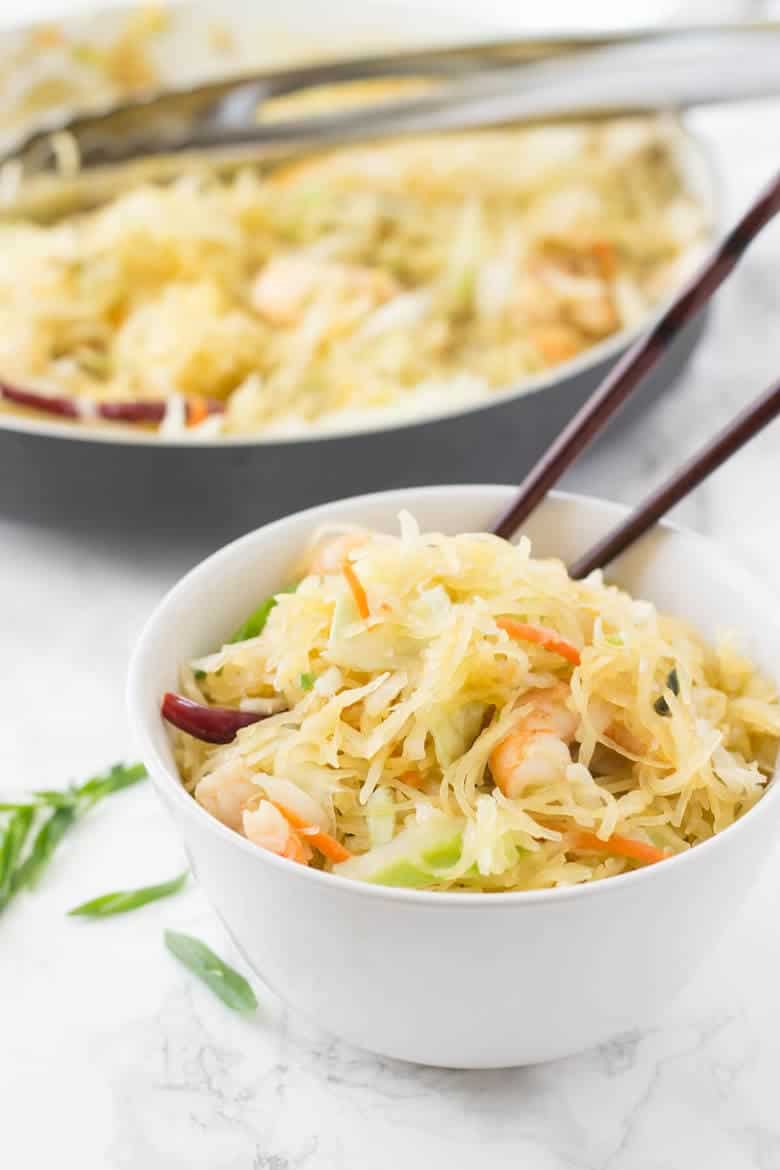
More Paleo Asian Recipes
If you want to try and recreate that Chinese Buffet feel at home, then check out these awesome healthy Chinese takeout alternatives:
- Chinese Almond Chicken
- Paleo Chinese Chicken Lettuce Cups (these are whole30 compliant, too!)
- Spicy Asian Green Beans
All these meals are quick and easy to prepare, offer health boosting heat and spices, and are low carb, too.
RECIPE CARD
Easy Paleo Healthy Shrimp Chow Mein Recipe
This easy, healthy shrimp chow mein recipe is perfect for weeknight dinners - all the flavors of your favorite takeout, in a paleo, low carb version that's cheap, too!
Ingredients
Please ensure Safari reader mode is OFF to view ingredients.
- 1 medium Spaghetti squash
- 3/4 lb Shrimp (peeled and de-veined)
- 4 cups Coleslaw mix
- 2 medium Green onions (sliced)
- 2 cloves Garlic (minced)
- 2 medium Thai dried red peppers
- 1/4 teaspoon Fresh ginger (minced)
- 10 medium Sichuan peppercorns
- 1 tablespoon Sesame oil
- 2 tablespoons Coconut aminos
- 1 pinch Sea salt
- 1 pinch Coconut sugar (optional)
Instructions
More TIPS about this paleo recipe in the post above!
Preheat oven to 375° F. Cut the squash in half, bake for 40-50 minutes or until tender. Remove from oven and use a fork to shred into "noodles".
Combine the minced garlic, ginger, green onion, chile peppers, and peppercorns. Heat the sesame oil over medium high heat and stir fry the mix until fragrant about1minute . Add in the shrimp and cook just until pink on both sides. Stir frequently so the garlic mix doesn't burn.
Add in the slaw mix and cook 1-2 minutes until slightly softened.
- Add in spaghetti squash and stir until combined. Pour the coconut aminos over and toss. Taste for salt and add a pinch or two if needed. You can also add a pinch of coconut sugar to bring out the sweetness of the shrimp but it's not necessary.
Recipe Notes
Serving size: ~2 cups, or 1/4 of entire recipe
Nutrition Information Per Serving
Where does nutrition info come from? Nutrition facts are provided as a courtesy, sourced from the USDA Food Database. Net carb count excludes both fiber and sugar alcohols (though the latter are rarely seen on this site), because these do not affect blood sugar in most people. We try to be accurate, but feel free to make your own calculations.
© Copyright Wicked Spatula. We'd LOVE for you to share a link to this recipe, but please DO NOT COPY/PASTE the recipe instructions to social media or websites. You may share a photo with a link back instead.
Did you make this recipe?
Click here to leave a comment + star rating! ★★★★★
Then, share a pic on Instagram. Tag @wickedspatula or #wickedspatula!
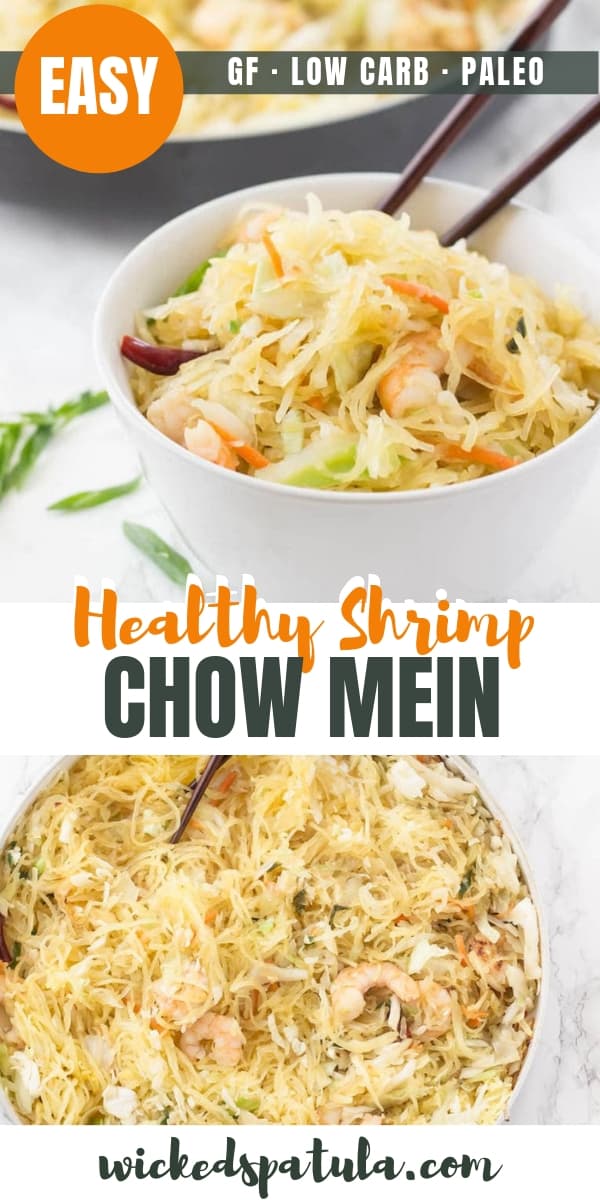
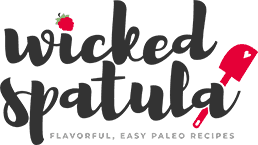
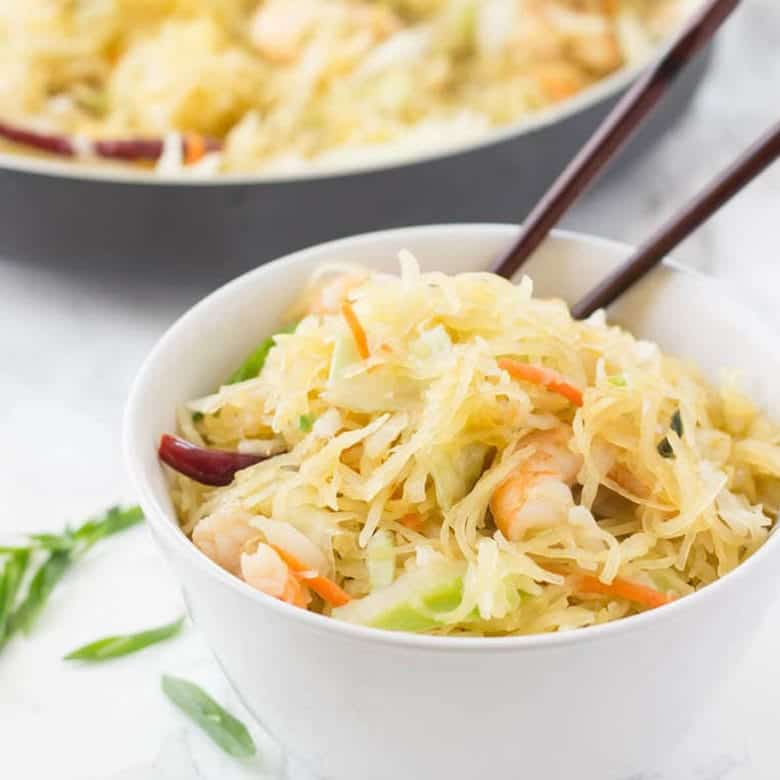

11 Comments
Angelina
Hi. Do you have a recommendation for a substitution for spaghetti squash? we don’t get spaghetti squash in our country.
Thanks
Taryn
Do you think I could make this with another protein? I love shrimp, but not hubby, was thinking chicken, pork or beef?
Lauren
Hi Taryn, Yes, you definitely can!
Taryn
Where do you buy the Sichuan peppercorns, and if an obscure store is there a sub you would recommend?
Lauren
Hi Taryn, The link to buy the peppercorns has been added to the recipe card above!
Sandra
Can you please provide the nutritional value content?
Lauren
Yes, the nutrition info has been added to the recipe card.
Anna
When do you add the coleslaw? Is that what you stir fry or is it the seasoning that you stir fry? Is there also a sub for the peppercorns? Thanks for your help!!
By the way, your blog is great and the recipes we have tried, all have been delicious!
Lauren
Hi Anna! I’m so glad to hear that! For this recipe you’ll add in the cabbage right after the shrimp are cooked. I’ve updated the recipe.
Lili
Hello – you’ve got this recipe tagged under vegetarian and shrimps ain’t vegetarian!
Lauren
You’re right, they aren’t! Simple mistake 🙂